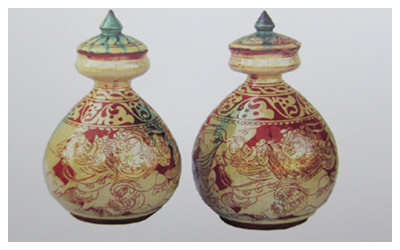Skype: neodalle-travel
Tel: +86 135 7447 2266
E-mail: sales@zhangjiajieholiday.com

 Jieshou Tri-colored Pottery with incised design is the treasure of folk art, with many remnants of its kind unearthed from the Liuzi Canal Site of the Grand Canal of the Sui and Tang Dynasties in Huaibei City, one of the China’s Top 10 Archeological Discoveries in 1999, and some utensils collected at the Victoria and Albert Museum of England.
Jieshou Tri-colored Pottery with incised design is the treasure of folk art, with many remnants of its kind unearthed from the Liuzi Canal Site of the Grand Canal of the Sui and Tang Dynasties in Huaibei City, one of the China’s Top 10 Archeological Discoveries in 1999, and some utensils collected at the Victoria and Albert Museum of England.Jieshou Tri-colored Pottery with incised design is mainly distributed at the south bank of the Ying River in Jieshou City, Anhui Province, scattering along about 13 villages, which are all named with kiln names owing to the villagers living on pottery-making. The 13 villages, now under the jurisdiction of Tianying Town, Jieshou City, Anhui Province, have a general name “Thirteen Kilns”. Established at Shunhe Road, north bank of the Ying River in Jieshou City in 1958, the Jieshou City Craft Ceramics Factory has been the major producer of the tri-colored pottery with incised design.
Originating in the Tang Dynasty, the technique of Jieshou Tri-colored Pottery has created its own style in the ceramics technology by inheriting the style of Tang Tri-colored Pottery and adopting the artistic style of Chinese paper-cut and New Year Woodcut.
The manufacturing technique, theme and color of the Jieshou Tri-colored Pottery are simple, straightforward and massive. To adapt to the above styles, the Jieshou Tri-colored Pottery is featured with two-layer colored paste on body as well as two contrasting colors of reddish brown and yellow or reddish brown and white. Moreover, when it comes to the themes, apart from flowers, birds, fish and insects of real life, it also picks up artistic elements of traditional Chinese operas and integrates them into different scenes for better expression. Among them, the design of warriors riding horse and holding sword created by Lu Shanyi stands out. The Jieshou Tri-colored Pottery expresses the honest and simple character and rustic and artful aesthetic interest of farmers in the north and reflects the aesthetic tendency of advocating nature and pursuing harmony of folk art.
 Ask Questions ?
Ask Questions ?